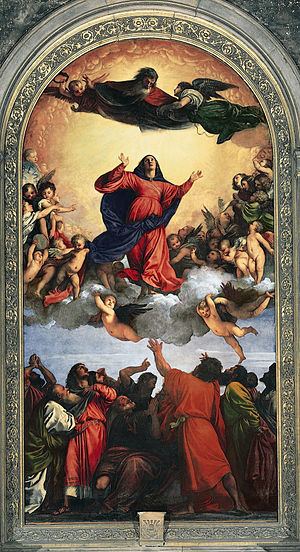Year 1516–18 Created 1516–1518 | Medium Oil on panel Dimensions 6.9 m x 3.6 m Media Oil paint | |
 | ||
Location Santa Maria Gloriosa dei Frari Similar Titian artwork, Italian Renaissance artwork, Oil paintings | ||
Titian assumption of the virgin renaissance reformation in europe art history khan academy
Assumption of the Virgin is a large oil painting by Italian Renaissance artist Titian, executed in 1516–18. It is located on the high altar in the Basilica di Santa Maria Gloriosa dei Frari in Venice, being the largest altarpiece in the city.
Contents
- Titian assumption of the virgin renaissance reformation in europe art history khan academy
- The assumption of the virgin by titian
- History
- Description
- References
The assumption of the virgin by titian
History
The Assumption of the Virgin was Titian's first major commission in Venice. He soon became the lead painter of Venice. Breaking tradition with its heroic character scale and trademark color, its twisted Virgin and dramatically gesturing apostles disturbed passersby. This panel was important in establishing Titian's popularity in Venice. According to some sources, an envoy to the emperor Charles V was present at the unveiling ceremony; he asked the Franciscans, who were doubtful about the painting's quality, to buy it lest they were tempted to remove it.
When Titian placed this giant painting in its majestic marble frame, it garnered much attention. It was deemed worth noting by the Venetian diarist, Marino Sanuto the Younger, who wrote, "May 20, 1518: Yesterday the panel painted by Titian for ... the Minorites was put up."
In 1818, it was moved to the Accademia, returning to its original place at the Frari in 1919. Viewing the painting while housed in the Accademia, the young Oscar Wilde remarked that The Assumption was "certainly the best picture in Italy."
Description
Titian may have trained as a mosaic artist, and it has been suggested the golden background is a homage to the tradition of Venetian mosaics. Titian primarily used oil-ground paint, which was prepared by his assistants. No one has the exact recipe, but the basic ingredients included linseed oil and gum turpentine. The heroic figures and size were a new idea when the Assumption was placed in the Basilica; the scale allows the painting to be appreciated from various viewpoints within the church.
This picture shows different events in three layers. In the lowest layer are the Apostles. They are shown in a variety of poses, ranging from gazing in awe, to kneeling and reaching for the skies. In the center, the Virgin Mary is drawn wrapped in a red robe and blue mantle. She is raised to the heavens by a swarm of cherubim while standing on a cloud. Above is an attempt to draw God, who watches over the earth with hair flying in the wind. Next to him, flies an angel with a crown for Mary.
